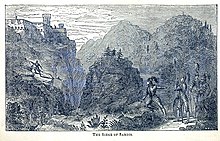Siege of Sardis
| date | December 547 BC Chr. |
|---|---|
| place |
Sardis , Lydia |
| output | Victory of the Persians |
| Territorial changes | Lydia |
| consequences | Lydia is captured by the Persians |
| Parties to the conflict | |
|---|---|
| Commander | |
|
Cyrus II , King of the Old Persian Empire |
Croesus , King of the Lydians , Harpagus
|
The siege of Sardis in 547 BC BC was the decisive battle in the conflict between Croesus , king of Lydia, and the Achaemenid king Cyrus II. After Croesus withdrew to his capital Sardis , Cyrus followed him and besieged the city for 14 days until he took it. The most important contemporary source for the events are the "histories" of the ancient historian Herodotus .
Starting position
After Cyrus II. 550 BC BC that Lydia had conquered neighboring media , Croesus felt threatened by the overpowering Persian king. At the same time he wanted to avenge the overthrow of his brother-in-law, the Median king Astyages , and to enlarge his own territory. Before his attack he allied himself with Sparta , the Babylonian king Nabonaid and Amasis of Egypt , but did not wait for their arrival.
After interrogating the oracle of Delphi , Croesus crossed the border river Halys and invaded Cappadocia , where he met Croesus at Pteria . The battle ended without a clear winner and so Croesus withdrew to gather strength and wait for the allies. Croesus dismissed large parts of the army and went to Sardis to spend the winter in the suspicion that Cyrus II would not follow him and set up his winter camp in Cappadocia. However, when he heard that Croesus had dismissed large parts of his armed forces, he crossed the Halys and hurriedly moved towards Sardis. Croesus then gathered his remaining troops and met Cyrus II in the battle of Thymbra . Although the troops of Croesus were outnumbered, Cyrus was able to put the Lydians to flight.
siege
Croesus was confident of keeping Sardis because the city with its citadel was believed to be well fortified and prophecies had foretold that Sardis would never be conquered. He had also asked Sparta , the strongest state in Greece, which was a loyal ally, for help, and hoped to re-integrate the Egyptians and the Babylonians into a coalition against Persia. The Spartans, however, were bound in a war against Argos , the other allies could not reach Sardis in time.
Cyrus II, on the other hand, motivated his soldiers with a reward for whoever was to climb the fortress wall first. But the first Persian attacks in December 547 BC. Were beaten back bloody. Cyrus then besieged the city for 14 days.
According to the histories of Herodotus , Sardis fell to the Persian soldier Hyroiades. Hyroiades had seen a Lydian soldier climb down the walls and down the steep castle rock because he had lost his helmet. The place was hardly guarded because it was considered insurmountable because the rocks here were very steep. The next day the Persians climbed the castle rock in the same place and immediately took the city. A fragment of the historian Ktesias von Knidos reports, however, that the Persians held wooden dolls on poles over the top of the wall of Sardis and thus caused panic among the besieged, so that the city fell into the hands of Cyrus II.
consequences
Cyrus had ordered Croesus to be spared and the Lydian king was brought before the cheering enemy. Herodotus reports that Cyrus wanted to have Croesus burned at the stake in public, but took pity after Apollo , according to legends, intervened and let the fire go out with a heavy rain. Ktesias, on the other hand, tells of a multiple miraculous liberation of Croesus from his bonds, so that the Persian king finally amnestied him. It is unclear whether Croesus actually survived the capture of the city.
With the fall of Sardis, Lydia became the Persian satrapy of Sparda. A short time later, the tributary cities of Aeolia and Ionia also fell to Cyrus II. Persian dominance in the region did not end until the Persian Wars .
Individual evidence
- ↑ Pierre Briant: From Cyrus to Alexander: A History of the Persian Empire ( en ). Eisenbrauns ,, ISBN 9781575061207 , p. 36.
- ^ Herodotus , Histories 1, 46, 73, 75
- ↑ Herodotus, Histories 1, 6; 1.69; 1, 77.
- ↑ Croesus . In: Encyclopaedia Iranica , accessed March 24, 2020
- ↑ Herodotus, 1, 71
- ↑ Herodotus, 1, 72
- ↑ Herodotus, 1, 73
- ^ Herodotus, 1, 73, 74
- ↑ Herodotus, 1, 75
- ↑ Ktesias, Persika , fragment 23
- ↑ Herodotus, 1, 77
- ↑ Ktesias, Persika , fragment 23.


